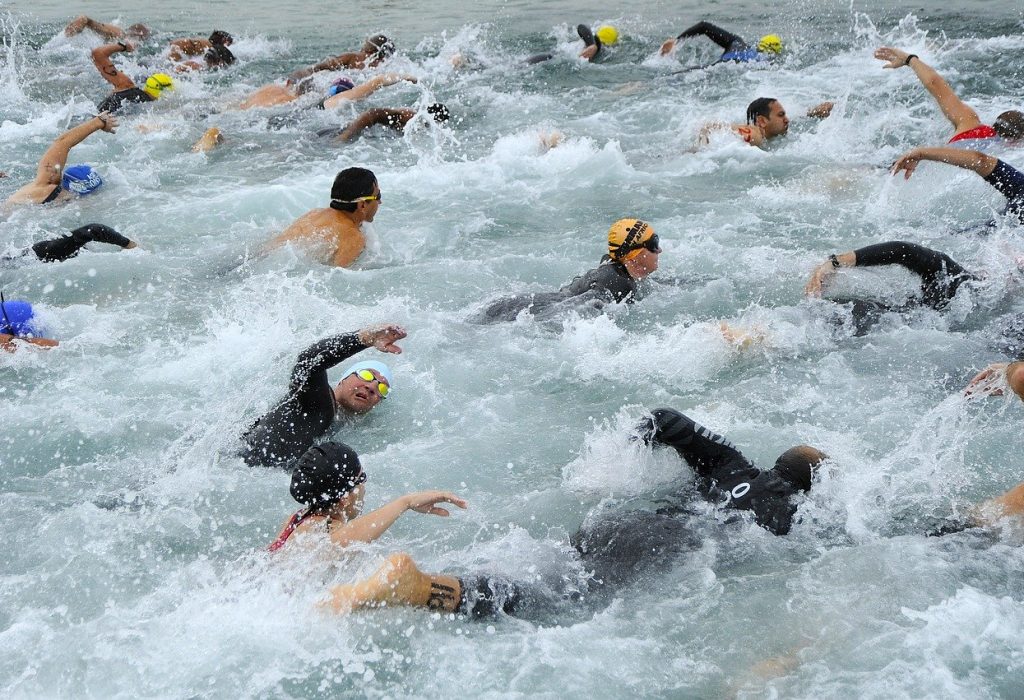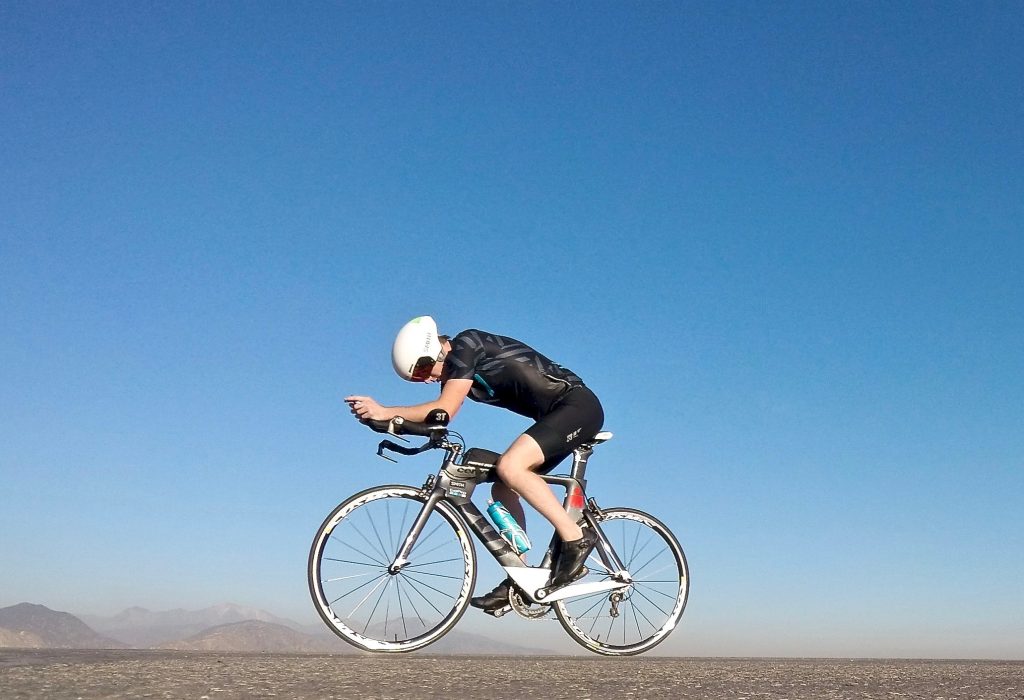How long is a triathlon?
How far is a triathlon exactly? Which distance should I sign up for? Check out our guide to all the common triathlon race distances.
So you’re thinking about doing a triathlon – great! But exactly how long is a triathlon? Before signing up you’ll want to know exactly how far you need to swim, bike, and run to get to the finish line.
There are lots of triathlon distances to choose from, which can be confusing when they’re referred to by name and not by distance. We’ve broken down the different races here to help you decide what race is the right one for you. You don’t want to sign up for an Ironman unless you know what you’re getting yourself in to!
Triathlon Race Distances
| Name | Swim | Bike | Run |
|---|---|---|---|
| Super Sprint | 0.4km (0.25mi) | 10km (6.2mi) | 2.5km (1.6mi) |
| Sprint | 0.75km (0.5mi) | 20km (12.4mi) | 5km (3.1mi) |
| Olympic/Standard | 1.5km (0.9mi) | 40km (24.8mi) | 10km (6.2mi) |
| Half Ironman | 1.9km (1.2mi) | 90km (55.9mi) | 21km (13.1mi) |
| Full Ironman | 3.8km (2.4mi) | 180km (111.9mi) | 42km (26.2mi) |
Super Sprint: 0.4km – 10km – 2.5km
This is an ideal distance for someone who wants to try triathlon for the first time. Despite the name, you do not have to sprint the whole race. Even if you’re starting from a very low fitness level, anyone can complete a super sprint with the right motivation and time to prepare. You can experience the thrill of a multisport event without having to train for too long.
If you’re looking to get fitter, entering a super sprint event gives you a great goal to aim for. It also helps build your confidence in triathlon before entering a longer event. You don’t need to invest in much equipment to complete a super sprint triathlon. A full breakdown of the necessary kit can be found here. The swim is usually done in a pool so there’s no need for a wetsuit.
If it’s your first triathlon, you shouldn’t worry too much about your finishing time. At this stage, it is all about having a fun experience. However, as a reference, the race usually takes between 45 and 90 minutes to complete. Depending on your fitness level, you would want between 6 and 12 weeks to prepare for this distance. A simple training plan can be found here.
Sprint: 0.75km – 20km – 5km
Many events offer this as the shortest distance. If you have a good base level of fitness, this is the perfect race to start your triathlon journey. It’s short enough that the training requirements are manageable but still provides a tough challenge.
There are usually lots of first-timers competing in sprint distance events. It’s also popular with more experienced triathletes, who like to race for a shorter time at a higher intensity. Most swims will be in a pool, but some feature a sea or lake swim. Consequently, you may need to buy a wetsuit and get comfortable with swimming in open water.
You can expect to be racing for somewhere between 1.5 and 2.5 hours, so it’s more of a marathon than a sprint (but much easier than a marathon). 8 to 12 weeks of training should be enough to get you to the start line in great form.

Olympic: 1.5km – 40km – 10km
As the name suggests, this is the distance that is raced in the Olympics, so you can get a taste of what many pro triathletes train for. If you are looking for a big challenge or have experience in endurance sport, you could choose this for your first triathlon. However, for most people, a shorter distance would be a better choice for your first race. You can always build up to an Olympic event in the future.
Due to the increased distance, you will need to think more about your pacing and nutrition strategy. Practicing taking in food while exercising will be a key part of your training plan. You also need to make sure you incorporate brick sessions into your training. This involves doing a run immediately after a bike ride, to get used to the feeling of running with jelly legs. Most events of this distance will feature an open water swim so you will need to practice this.
An ambitious first-timer could aim for this distance if they can train for around 5 hours per week for at least 12 weeks. The race can take somewhere between 2 and 4 hours.
Half Ironman: 1.9km – 90km – 21km
Also known as a 70.3 (the total distance in miles), this distance is a serious challenge and a big step up from the Olympic distance. You should make sure you are fully prepared for the demands of this event. Ideally, you will have completed at least one Olympic race and be able to complete each of the three elements comfortably in training.
The training requirements are much greater here but are still achievable for someone with a busy schedule. Managing aspects of your lifestyle like recovery and nutrition will be important. Furthermore, you will need to have adequate gear to keep you comfortable for the entire race.
The suggested time to prepare for a 70.3 is about 16 weeks of training for at least 8 hours a week. Pro triathletes can complete the race in about 4 hours, but most people usually race for between 6 and 8 hours.

Ironman: 3.8km – 180km – 42km
This is double the distance of a half Ironman and the decision to enter this race should not be taken lightly. Some people have entered an Ironman as their first ever race. However, you will be far more confident if you have tackled some of the shorter distances first. It can be helpful having a massive goal like an Ironman to aim for, but spending a year or two developing your endurance before entering will put you in a much better place to finish.
If you want to tick this event off your bucket list, make sure you give yourself plenty time to prepare. Just completing the event within the time limit requires consistent training for at least 6 months, or far longer if you’re starting from scratch. For many people, this is a once-in-a-lifetime achievement.
Training for an Ironman requires at least 13 hours of training per week, so make sure you can fit it around your other commitments. Races have a cut off time of 17 hours with most participants completing the event in 12 to 15 hours. If you want to know what pace you need to sustain to complete an Ironman, check out our guide to the cut off times here.
What race should you enter?
Completing any of these events is a massive achievement. The variety of distances in triathlon means that there’s a race for everyone. The shorter events are great for someone wanting to try a triathlon for the first time, while the longer distances allow people to keep challenging themselves as they become fitter and more experienced. If you’re looking to progress, you can either try and go faster for the same distance or enter a longer race. Hopefully, this guide will help you make the decision to enter the race that is right for you.
Already entered your first race? Check out our beginner’s guide to training for your first triathlon.
Need some new kit to help you on your triathlon journey? We have a range of buyer guides to help you choose the best gear for you.
Email: contact@smarttriathlete.com